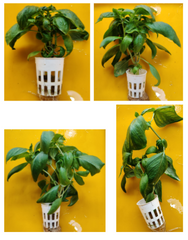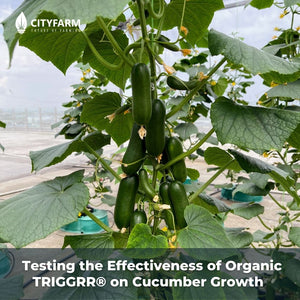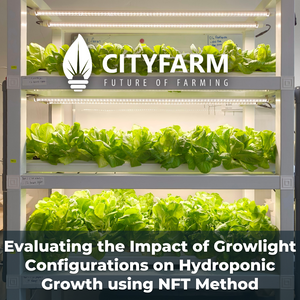[Research] Effects of Photoperiodism on Plant Growth
![[Research] Effects of Photoperiodism on Plant Growth](http://cityfarm.my/cdn/shop/articles/11_37_1024x.png?v=1646033497)
[Research] Effects of Photoperiodism on plant growth (single 12 hours session vs multiple sessions cumulatively 12 hours)
Introduction
Following the increasing interest in urban farming and hydroponics, many users are slowly looking to grow their own food with household farming setups. For these urban farmers, not all of them have sufficient outdoor spaces that provide sufficient natural sunlight to the plants, instead, they look towards artificial horticulture growlights as a substitute. In comparison, as natural sunlight is much stronger, plants only require approximately 8 hours of sunlight per day for healthy growth, whereas for artificial lighting, it is recommended that these indoor setups are exposed to at least 10 to 14 hours of lighting per day to achieve similar growth results (D’anna, 2021).
However, the usual concern with the statement above is related to none other than the expensive electricity costs that accompany the long hours of turning on the growlights. Additionally, following the Enchanced Time of Use (ETOU) tariff scheme launched by TNB which offers different tariff rates at different times of the day, urban farmers have a better chance at evaluating and reducing their operational costs while growing their passion (Tenaga Nasional Berhad, n.d.).
As seen below, Figure 1 shows the exact timing of the time zones for Peak, Mid-Peak and Off-Peak on weekdays, while Figure 2 shows the different charges for these respective time zones. Subsequently, the lighting requirement for indoor hydroponic farming can be carefully planned according to this information to achieve maximum energy savings without affecting the plant growth. This experiment is carried out to observe the practicality of splitting the lighting requirement for indoor plants into shorter periods, so that these plants have the same cumulative amount of lights across the day instead of a consecutive lighting for 10 hours a day to fit into the Off-Peak time zones. Thus, it is hypothesised that if the plants receive the same cumulative amount of lighting per day (despite splitting it into shorter, separate periods), the plants would have a similar growth rate.

Figure 1. TNB Enhanced Time of Use (ETOU) time zones

Figure 2. ETOU rate for different categories
Materials
- Digital Timers x 2
https://cityfarm.my/products/timer
- 4ft 2”x4” NFT Channels x 4
https://cityfarm.my/products/4-feet-120-cm-nft-channel
- Kintons 101 5W Pump
https://cityfarm.my/products/kintons-101-pump-5watt-1m-800l-h
- Hanna Instruments GroLine Monitor for Hydroponic Nutrients HI981420
https://cityfarm.my/products/groline-monitor-for-hydroponic-nutrients
- A & B Liquid Fertiliser for Leafy Greens
https://cityfarm.my/products/hydroponics-fertilizer
- 4ft Cityfarm Horticulture Full Spectrum T8 Growlights (Pin Connection)
Types of Vegetable Used
- Romaine Lettuce (germinated on 15/9)
- Half-Red Amaranth (germinated on 18/9)
- Hong Kong CaiXin (germinated on 18/9)
- Thai Basil (germinated on 11/9)
Methodology
This experiment started on the 29th of September and ended on the 30th of October. It was conducted in a City Vertical Farm M (Figure 3), which consists of 2 layers. The top layer was set up as the control plants, which the timer for the growlights were set to run for 12 consecutive hours every day from 6am to 6pm. On the other hand, the bottom layer was the experimental layer where the plants in this layer were exposed to 3 different sessions of 4-hour-period lighting throughout the day, these periods are 6am - 10am, 12pm - 4pm as well as 6pm - 10pm. It is important to note that both setups are still exposed to 12 hours of light per day.
Each layer holds two 4ft NFT channels which provide a total capacity of 32 plants for the experiment, 4 seedlings from each vegetable type were placed within the NFT channels as seen below in Figure 2. Aside from the lighting alterations made for the experiment, the remaining setup for the Vertical Farm M is identical to the usual hydroponic practices. The EC readings for the water tank was measured and maintained daily between 1.2 - 1.4 mS/cm, while the pH levels of the water was maintained above 5.5 to ensure the healthy growth for the plants.
Additionally, pictures of the plants were taken every 3 days from the start of the experiment to help visualise the differences between both setups as well as the differences between the locations of each plant within the same setup (due to the slight differences of light exposure from the plants’ positions). At the end of the experiment, the plant growth was measured using the fresh weight of the full plant after the harvest period, the mean weight of the plants were used to compare between both setups.

Figure 3. A 3D computer generated model of City Vertical Farm M
Results
Table 1. Post-experiment Fresh Weight Measurements
|
Plant Types |
|
Weight of Plants (kg) |
Mean Weight (kg) |
|
Half Red Amaranth |
Control |
0.04 |
0.051 |
|
0.046 |
|||
|
0.053 |
|||
|
0.065 |
|||
|
Experiment |
0.014 |
0.027 |
|
|
0.028 |
|||
|
0.034 |
|||
|
0.032 |
|||
|
Hong Kong Caixin |
Control |
0.015 |
0.0213 |
|
0.021 |
|||
|
0.03 |
|||
|
0.019 |
|||
|
Experiment |
0.012 |
0.019 |
|
|
0.018 |
|||
|
0.021 |
|||
|
0.023 |
|||
|
Romaine Lettuce |
Control |
0.085 |
0.068 |
|
0.07 |
|||
|
- |
|||
|
0.05 |
|||
|
Experiment |
0.081 |
0.07 |
|
|
0.084 |
|||
|
0.075 |
|||
|
0.041 |
|||
|
Thai Basil |
Control |
0.057 |
0.057 |
|
0.069 |
|||
|
0.064 |
|||
|
0.036 |
|||
|
Experiment |
0.03 |
0.042 |
|
|
0.055 |
|||
|
0.047 |
|||
|
0.035 |
As mentioned above, pictures of the plants were taken throughout the experiment, as there were a lot of pictures from the experiment, only the pictures from Day 1, Day 14, and Day 30 will be shown below to help visualise the differences of the plants.
Half Red Amaranth
Day 1 Control Day 1 Experimental


Day 14 Control Day 14 Experimental


Day 30 Control Day 30 Experimental


Hong Kong Caixin
Day 1 Control Day 1 Experimental


Day 14 Control Day 14 Experimental


Day 30 Control Day 30 Experimental


Romaine Lettuce
Day 1 Control Day 1 Experimental


Day 14 Control Day 14 Experimental


Day 30 Control Day 30 Experimental


Thai Basil
Day 1 Control Day 1 Experimental


Day 14 Control Day 14 Experimental


Day 30 Control Day 30 Experimental


Discussion
Photoperiodism, otherwise defined as the physiological reaction of organisms to the length of the dark period, is one of the most researched topics on both animals and plants. For plants, photoperiodism is particularly important as certain plant species require a specific duration of dark period in order to achieve their flowering and fruiting process.
In this experiment, it is observed that all control plants (aside from the Romaine Lettuce) grew slightly better when compared to its experimental counterparts. For the experimental plants, there is clear evidence of stem elongation throughout the growing phase, as seen in the pictures above. This is particularly visible for the Thai Basil as well as the Half-Red Amaranth plants. However, there were also slight differences between the experimental samples as some of the plants may not have received sufficient lighting due to its positioning in the NFT channels (especially around the edges of the NFT channels where the plants were not directly exposed to the lighting, which led to poor growth and stem elongation.
Additionally, it is also noted that most of the control plants managed to accumulate a higher biomass. Aside from the Romaine lettuces which showed little to no differences among the two setups, the remaining plant species recorded visible average weight differences. It is also important to note that there were cases of pest infestations during the experiment, which severely affected the Hong Kong Caixin plants. While immediate pest management measures were immediately taken once the issue was spotted, the end result still showed poor growth for both the control and experimental setups.
In a similar study conducted by Folta in 2019, the team experimented on ways to reduce energy requirements for farming in controlled environments. Rather than setting multiple 4-hour sessions of lighting, they experimented on various light-dark cycles, ranging from hours to seconds. Unfortunately, most of the longer cycles (6 hours, 3 hours, 1 hour, 30 minutes) showed that the plants grew as if they were in a light-deficient environment, thus the stems elongated to search for an alternative light source. However, when they further reduced the duration of light-dark cycles to approximately 5-20 seconds, the seedlings grew as if they had received 12 hours of regular lighting.
In conclusion, while the findings by Folta correspond to the findings in this experiment, it seems that it is difficult for everyday users or hobbyists to be able to tackle the energy cost without sufficient access to technology to alter the lighting cycles without affecting plant growth. As of now, in order to save on energy costs for indoor farms, the only method now would be to operate these farms during off-peak hours.
References
D’anna, C. (2021). The Basics of Hydroponic Lighting. Retrieved from https://www.thespruce.com/hydroponic-lighting-basics-1939224
Folta, K. (2019). Micro-naps for plants: Flicking the lights on and off can save energy without hurting indoor plants. Retrieved from https://explore.research.ufl.edu/micro-naps-for-plants-flicking-the-lights-on-and-off-can-save-energy-without-hurting-indoor-agriculture-harvests.html
Tenaga Nasional Berhad (n.d.). TNB Enhanced Time of Use (ETOU). Retrieved from https://www.tnb.com.my/faq/etou/
- Bryan Chan (Queensland University of Technology)



![[Research] The Effect of Synthetic Fertilizer and Organic Fertilizer on Plant Growth (Green ribbon)](http://cityfarm.my/cdn/shop/articles/11_69_300x.png?v=1696511389)
![[ArtIcle] Urban Farming: Opportunities and Challenges](http://cityfarm.my/cdn/shop/articles/WhatsApp_Image_2023-05-18_at_14.53.55_300x.jpg?v=1684392966)
![[Article] The Future of Indoor Vertical Farming](http://cityfarm.my/cdn/shop/articles/11_ce4d60df-c15d-4168-9051-811d2f2db016_300x.png?v=1670699733)
![[Research] The Effect of Water Temperature on Plant Growth](http://cityfarm.my/cdn/shop/articles/11_43_300x.png?v=1653919657)